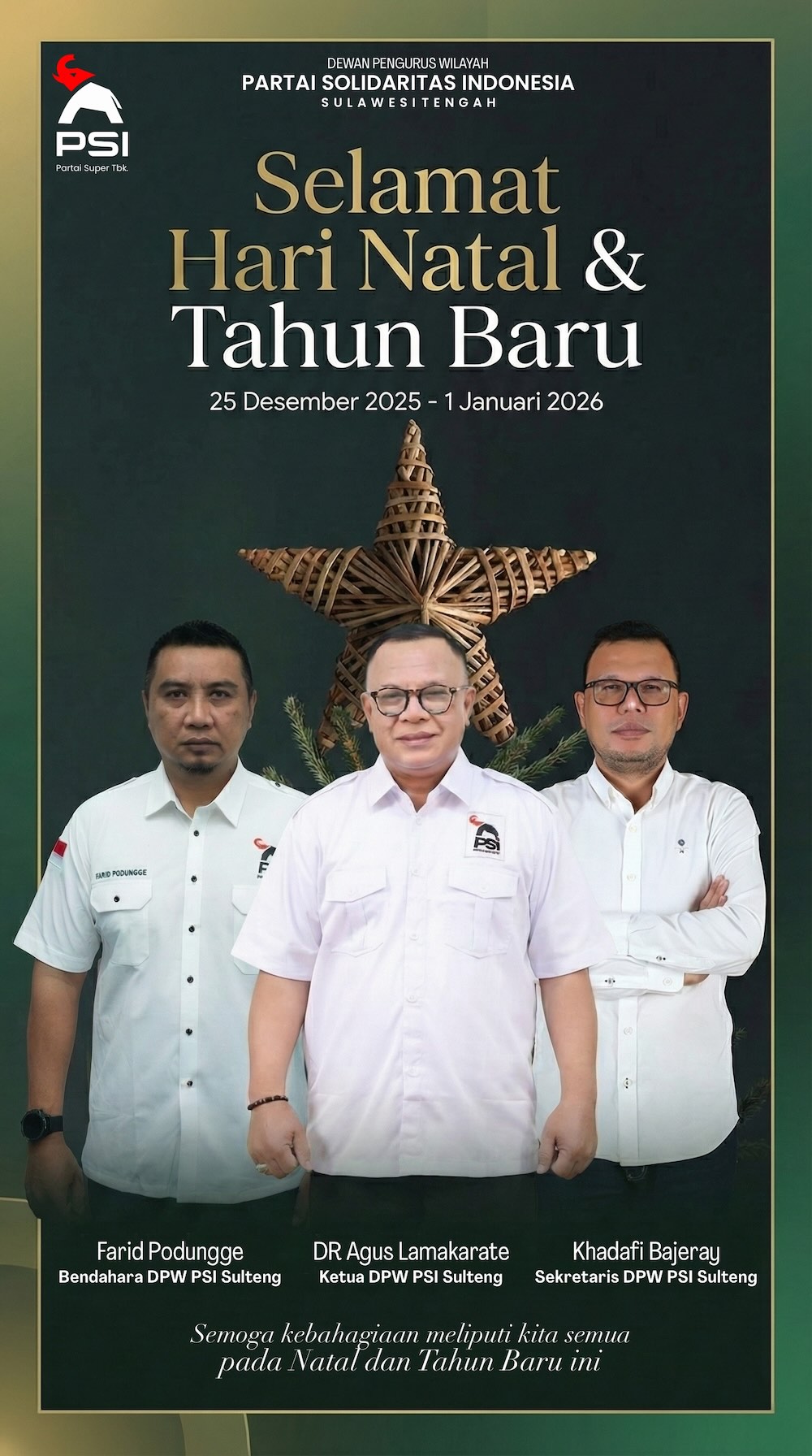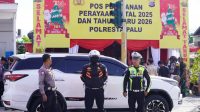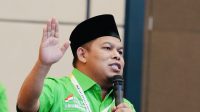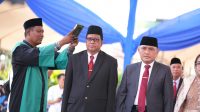 |
| – |
Editor: Andono Wibisono, Ikhsan Madjido, Idham & Wawan Karmawan
THE 2019 General Election has been partially completed. We are waiting for the
results of the calculation and determination of the President/Vice President of
the Republic of Indonesia, DPD, DPR RI, provincial DPRD, city/regency next 22
May. A political celebration that leaves a polemic, even though the outside
world is amazed by the election vote a day that is followed by hundreds of
millions of voters.
results of the calculation and determination of the President/Vice President of
the Republic of Indonesia, DPD, DPR RI, provincial DPRD, city/regency next 22
May. A political celebration that leaves a polemic, even though the outside
world is amazed by the election vote a day that is followed by hundreds of
millions of voters.
In Central Sulawesi Province, the election of governors/deputy
governors, mayors/deputy mayors and a number of districts will be held in 2020.
This five-year political event will be crowded for the election of the governor/deputy
governor of Central Sulawesi. Because the Pilgub 2020 is not incumbent. Given
Longki Djanggola has been two periods.
governors, mayors/deputy mayors and a number of districts will be held in 2020.
This five-year political event will be crowded for the election of the governor/deputy
governor of Central Sulawesi. Because the Pilgub 2020 is not incumbent. Given
Longki Djanggola has been two periods.
Kaili Post’s Daily R & D and online media subsidiary kailipost.com
conducted a poll (giving questions to the public) figures who had popularity in
Central Sulawesi. The poll was conducted from April 29 to May 8, 2019. The poll
was held aimed to find out the extent to which the Central Sulawesi public knew
several political figures, bureaucracy, businessmen and young leaders who were
predicted to compete in the Pilgub arena.
conducted a poll (giving questions to the public) figures who had popularity in
Central Sulawesi. The poll was conducted from April 29 to May 8, 2019. The poll
was held aimed to find out the extent to which the Central Sulawesi public knew
several political figures, bureaucracy, businessmen and young leaders who were
predicted to compete in the Pilgub arena.
Kaili Post’s R & D Polling uses google docs, with the possibility
of being very open to respondents adding characters who are not in the poll
listing. Thus, the respondent is so very free and independent in determining
his choice without framing (bound) with the character given. During the 11 days
of polling, 1,396 respondents were spread across Central Sulawesi.
of being very open to respondents adding characters who are not in the poll
listing. Thus, the respondent is so very free and independent in determining
his choice without framing (bound) with the character given. During the 11 days
of polling, 1,396 respondents were spread across Central Sulawesi.
As a result, Hidayat Lamakarate the provincial secretary is on the top
with 183 voters or 13.1%. Followed by Rusdi Mastura, the former Mayor is still
popular with 136 respondents or 9.7%. Then, Akhmad Ali (member of the DPR RI
Nasdem Faction) with a vote number of 117 (8.3%), Sigit Purnama Said (Pasha)
earned 97 votes or 6.9%, and Bartholemeus Tandigala Head of Central Sulawesi
BPBD received 86 votes (6.2 %).
with 183 voters or 13.1%. Followed by Rusdi Mastura, the former Mayor is still
popular with 136 respondents or 9.7%. Then, Akhmad Ali (member of the DPR RI
Nasdem Faction) with a vote number of 117 (8.3%), Sigit Purnama Said (Pasha)
earned 97 votes or 6.9%, and Bartholemeus Tandigala Head of Central Sulawesi
BPBD received 86 votes (6.2 %).
The popular ‘middle board’ figure in Central Sulawesi is in accordance
with the poll, namely; Supratman Andi Agtas (member of the Republic of
Indonesia DPR Gerindra Faction) with a vote of 60 votes or 4.3%, the second
place, Nurmawati D Bantilan, was only supported by 57 respondents with a
percentage of 4.0%. Furthermore, the name of Mayor Palu Hidayat received 55
voters or 3.9%. Followed by Regent Sigi Moh Irwan Lapatta with 51 respondents
dropping the vote at a percentage level of 3.6%, and there is the name of the
former Morowali Regent Anwar Hafid with a number of respondents who supported
as many as 50 votes or 3.5%.
with the poll, namely; Supratman Andi Agtas (member of the Republic of
Indonesia DPR Gerindra Faction) with a vote of 60 votes or 4.3%, the second
place, Nurmawati D Bantilan, was only supported by 57 respondents with a
percentage of 4.0%. Furthermore, the name of Mayor Palu Hidayat received 55
voters or 3.9%. Followed by Regent Sigi Moh Irwan Lapatta with 51 respondents
dropping the vote at a percentage level of 3.6%, and there is the name of the
former Morowali Regent Anwar Hafid with a number of respondents who supported
as many as 50 votes or 3.5%.
While for popular figures in Central Sulawesi who are ‘bottom’, there
are a number of names. Both currently in office and former bureaucrats. For
example, the names Muharram Nurdin, Muhiddin H Said, Kasman Lassa, Moh Basir
Cyio, and Samsurizal Tombolutu.
are a number of names. Both currently in office and former bureaucrats. For
example, the names Muharram Nurdin, Muhiddin H Said, Kasman Lassa, Moh Basir
Cyio, and Samsurizal Tombolutu.
WEAKNESS
The poll held by the Kaili Post Research and Development Center that
uses online electronic media – Google Docs, certainly has its own weaknesses.
Or in survey languages is a limited range of surveys to take pictures of events or attitudes
about something or something in a given period of time.
uses online electronic media – Google Docs, certainly has its own weaknesses.
Or in survey languages is a limited range of surveys to take pictures of events or attitudes
about something or something in a given period of time.
Kaili Post’s R & D realized that this poll had not targeted
multiple respondents who were outside the reach of the internet or rural areas.
multiple respondents who were outside the reach of the internet or rural areas.
“It must be difficult to access for residents whose internet network is
still weak or lacking. Central Sulawesi, 70 percent are still rural areas which
are still difficult to access the internet network. That’s one weakness of the
poll this time,” said the R & D member, Ikhsan Madjido.
still weak or lacking. Central Sulawesi, 70 percent are still rural areas which
are still difficult to access the internet network. That’s one weakness of the
poll this time,” said the R & D member, Ikhsan Madjido.
The second weakness, as an effect of the weakness of the first point;
namely the domicile of the respondent. “Because the internet network is weak in
some districts, of course, the respondents from the district are certain that
we hope the distribution of polls can represent all regions. But our prediction
is not significantly influential,” he explained.
namely the domicile of the respondent. “Because the internet network is weak in
some districts, of course, the respondents from the district are certain that
we hope the distribution of polls can represent all regions. But our prediction
is not significantly influential,” he explained.
The weakness of the Kaili Post Research and Development Center can be
as follows; respondents were difficult to detect gender, representation of
regions (distribution), access to telecommunications networks and the internet.**
as follows; respondents were difficult to detect gender, representation of
regions (distribution), access to telecommunications networks and the internet.**










